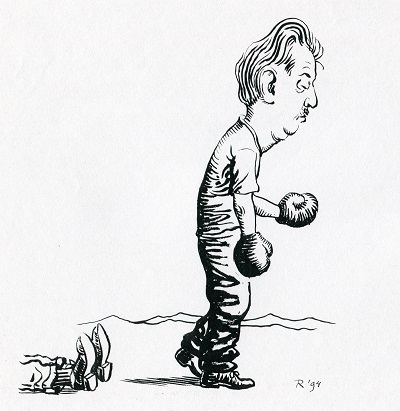
We are in the year 1994 – the first Donner Memorial Chess Tournament. Besides a ten-player event with top Dutch players and several foreign grandmasters, a group was composed with players who had faced Donner at the board. The ‘old fogeys’ group’, Jan Joost Lindner called it in de Volkskrant, and Eric Lobron wondered if he was watching Jurassic Park. With participants like Vasily Smyslov, David Bronstein, Ludek Pachman, Wolfgang Unzicker, Draguljub Velimirovic and Svetozar Gligoric you might indeed imagine yourself in long bygone days. Lindner also wrote about the ‘quiet surge of half points’, but there was at least one player who didn’t go along with this. The Yugoslav grandmaster Svetozar Gligoric showed anything but peacefulness with four wins, two defeats and three draws.
In the 1950s and 1960s, when the Soviet players ruled the chess world, Gligoric was one of the few players from other countries who could keep pace with them – at least, when it came to tournaments and international team contests. In the struggle for the world title he didn’t do so well. He didn’t get any further than two mediocre results in the Candidates tournaments of 1953 and 1959, and a Candidates match he lost against Tal in 1968. But outside the cycle, he won countless tournaments, became Yugoslav champion twelve times, and in the period 1950-1982 participated in the Yugoslav Olympiad team fifteen times – of which thirteen times on first board. With 88 wins, 26 losses and 109 draws, his Olympiad score was impressive.
Gligoric had a tough start in his life. He was born in poverty in 1923, lost his parents at a young age, and made his own chess set from corks, as we can read everywhere. Soon it became clear that he was talented, but the Second World War interrupted his chess development. Gligoric fought against the Germans in Marshall Tito’s partisan army, and rose to the rank of captain. It has been suggested that this break around his twentieth year was fatal for his final step to the absolute top. After all, it is precisely in that age category when you can grow quickly as a chess player.
The war doesn’t seem to have had any negative influence on his character. Gligoric was known as a gentleman among chess players. He tried to approach the game objectively, as a struggle between ideas not persons. For that reason also, his autobiography got titled I play against pieces. In this battle against the pieces, by the way, he was extraordinarily creative. He launched quite a few opening ideas, for example in the King’s Indian, the Ruy Lopez and the Nimzo-Indian.
In his later years, when he started playing a little less frequently, he earned fame as a chess author and commentator. He finished his book on the 1972 Fischer-Spassky match a few days after the match, and it had a circulation of more than 400,000 copies. Has this ever been equalled?
When Gligoric passed away in 2012, he was still a big name in Serbia – Yugoslavia had been dismantled by this time. He was buried in the Alley of the Greats in Belgrade’s new cemetery. From his later years, he left something very special to prosperity. One year before his death, he brought out a CD with compositions by himself. The album contains jazz, blues, ballads, and rap. I would certainly like to hear some of his rap compositions. The album title was Kako Sam Preziveo Dvadeseti Vek (How I survived the twentieth century). Some of the songs can be found on YouTube. (MbdW)